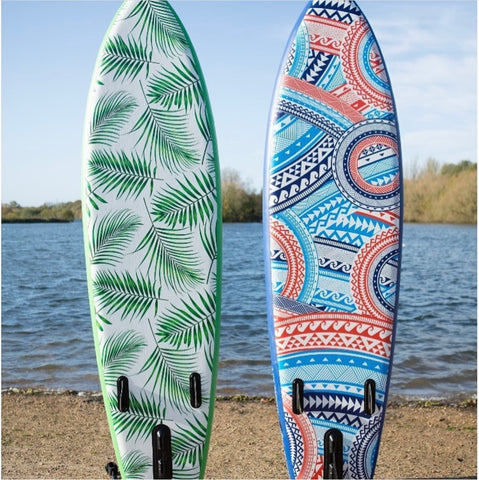It's an exciting day when you buy your first inflatable paddleboard and no doubt you are in a rush to find the nearest body of water, inflate the board as quickly as possible and take it out for it's maiden voyage. We sell lots of boards and every week we get customers doing just this and then ringing us up from the beach or the river bank to report faulty pump gauges or bendy boards because they haven't had time to read the manual and get to grips with setting up their inflatable SUP or kayak so we have put together a quick post on the most common mistakes that newbies make.
1 - ''The valve is broken and air comes out when I take the hose off'
The first time you pump up the board is always the hardest, right? So there is nothing worse than getting to 20 psi and removing the pump hose from the valve only to hear that loud noise of the air rushing out. It is easy to assume that this is because the valve is faulty but it is more likely to be that the valve was not in the correct position when you first attached the pump hose. The valve needs to be in the closed position which is done by putting the spring loaded pin in the up right position before you begin pumping to avoid the air coming out when you have finished pumping.

2 - ''The board is pumped up and solid but the pump gauge is not reading the pressure correctly''
The most common one that we get is assuming the board is at a higher pressure than it actually is and that the pressure gauge on the pump is not working properly. There needs to be a certain amount of air in the board before the gauge is able to register a pressure; this is normally about 4-5 psi. The board or kayak will look and feel solid before this time so it is easy to assume that it is at the recommended pressure and that the pump is faulty. Keep pumping and the gauge will register and then keep pumping a bit more until you get to the desired PSI (10-12 for kayaks & 18-20 for SUPs). The first couple of times can be quite tiring but once you get the hang of the technique it does get easier. If it doesn't get easier then you might want to look into an electric pump which takes all of the effort out for you so you can get ready for your paddle while it does the hard work.
3 - ''My board is bendy and it is hard to stand up on''
This ties in with the previous point about making sure you trust the pressure gauge and keep pumping until it reaches the correct pressure. If you take a board out when it looks solid but is not at the correct pressure it will bend in the middle like a banana and as a result you will struggle to stand up on it. One of the things that makes Sandbanks Style boards so great is that they are constructed with materials and processes which allow them to pump up to higher pressures and become noticeably more rigid than some other boards which makes standing up on them easier and more enjoyable.

4 - ''Pumping up the board is impossible''
There's no getting away from the fact that it is hard work pumping up an inflatable paddleboard especially on the first few attempts (apart from by buying an electric pump!). There are ways to make it easier for yourself. Firstly make sure you are taking advantage of the double action function on your pump. For the most efficient way to get air in the board start on double action. When this starts to get too hard for you to pump then swap to single action function which will only pump on the down stroke of the pump but will be a lot easier. Secondly, changing your technique may make it easier to get your paddleboard or kayak to higher pressures.Rather than using just your arms and tiring yourself it is good to vary the muscle groups. When pumping gets harder try locking your arms and do shorter pump strokes by bending your knees using your body weight to push the pump down; most people will find this a lot easier.
5 - ''The fin has come off whilst paddling''
It seems obvious but we get a lot of people not securing their central fins onto the board properly before going out on the water. If you have a Sandbanks Style click in fin then make sure once you have attached it to the board you pull it back (or push forward) slightly so that it cannot fall out of the gaps in the finbox. If you are using a fin with an American box (US) fin with the screw and bolt make sure that you have tightened the screw up enough that it doesn't move around in the fin box. No matter what type of fin you have take care when in shallow or rocky water and avoid putting weight on the board when it is on dry land as these fins can snap and can also cause damage to the fin box; neither of which are likely to be covered under a manufacture warranty.

For more information on how to set up an inflatable paddleboard see our recent video here.
Not only will setting your board up correctly the first time make your first trip out more enjoyable (and easier!) it will also ensure that you are heading out onto the water on a safe board.
Look out for our next blog on the most common mistakes we see people making when they get out on the water and how to resolve these.
Written Kristy Hobart
















Think deflation tips on this blog would be good. Particularly about if a board is being deflated best to let off a couple of PSI gradually before depressing the valve. The O ring on the valve can get unseated if the board is deflated aggressively!
Good to know I’ve got the setting up right. Look forward to the next instalment! Thanks.